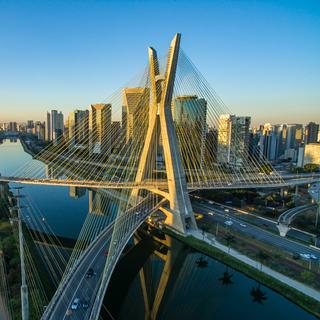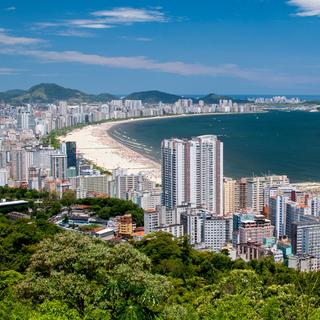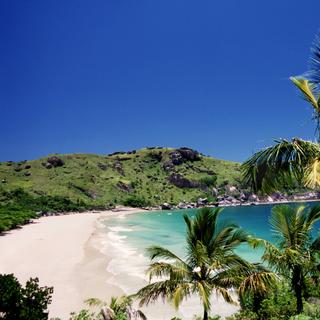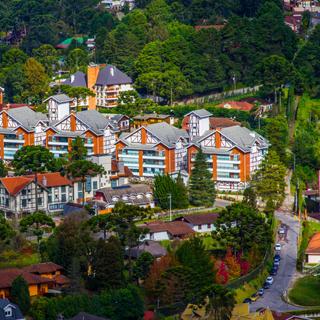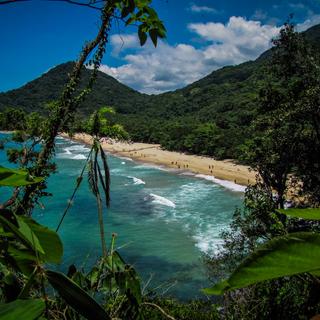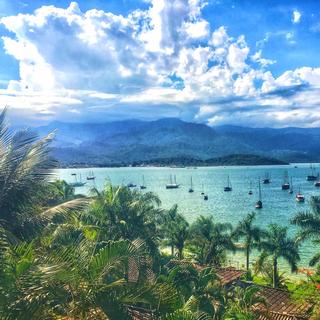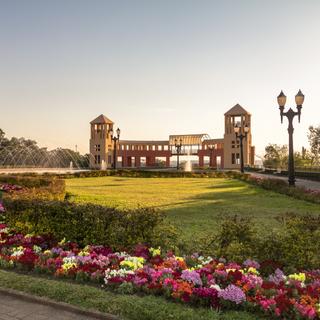Santo André weather and climate in 2026
Day
27 °C
Night
18 °C
Sea
27 °C
Precipitation
221 mm
in month
Rainy days
20 days
in month
Daylight
13 hours
average
Sunshine
5 hours
average
Humidity
80 %
Weather charts for Santo André
Find more destinations like this
Closest destinations for Santo André
Closest cities for Santo André
Weather overview for Santo André
Weather overview
Santo André, located in the southeastern region of Brazil, experiences a dynamic climate marked by warm summers and milder winters. The warmest months are usually December through February, with temperatures peaking around 26 °C (78 °F). Rain is a prominent feature in the city, peaking during the summer months, with an average of 21 days rainy days in December. Cooler and drier conditions settle in around June and July where the temperature hovers around 21 °C (70 °F). There are ample sunny hours throughout the year, so visitors and locals alike can enjoy the outdoors, though always with a chance of sudden showers.
January weather
January kicks off the year with adequate warmth and moist conditions. The city dances under a high daytime temperature of 27 °C (80 °F), which might encourage outings in the sun. Rainfall averages at 270 mm (10.62 in), suggesting a likely encounter with showers. Nights are mild with an average temperature of 17 °C (63 °F). Humidity lingers at about 80 %, often leading to a feeling of sultriness.
February weather
February maintains the city's warm summer vibes with an average maximum temperature of 27 °C (80 °F). Rain continues to make its mark with 221 mm (8.70 in) expected to fall throughout the month. The nighttime remains cozy with temperatures around 18 °C (64 °F). The wind speed is gentle, averaging 2 m/s, offering some relief from the heat.
March weather
In March, the city starts to transition, with the daytime temperature slightly decreasing to an average high of 26 °C (78 °F). Rainfall begins to ease off as well, with about 201 mm (7.91 in) expected. The cool breezes at night bring the temperature down to an average of 17 °C (62 °F), and the humidity remains relatively high at 81 %.
April weather
April sees a noticeable reduction in rainfall to approximately 104 mm (4.10 in), and the number of wet days starts to decline. The days are comfortably warm with a high temperature averaging 24 °C (76 °F). Nights cool down to a more tranquil 15 °C (59 °F). Wind speeds remain steady at 2 m/s, ensuring a gentle brush across the city.
May weather
May marks the onset of milder weather, with sunny skies becoming more prevalent, as evidenced by an increase to 46. Daytime temperatures are cooler, averaging 22 °C (71 °F), while precipitation drops to 74 mm (2.92 in). At night, temperatures fall to 12 °C (54 °F), and the wind picks up a little, average at 2 m/s.
June weather
June welcomes the driest season, bringing the average number of sunny hours up to 46 hours. The city experiences one of its lowest rain volumes at 58 mm (2.28 in) and fewer wet days, averaging 9 days. Day temperatures remain steady near 21 °C (70 °F). The nights can be quite cool with an average low of 11 °C (51 °F).
July weather
July's climate is characterized by the lowest daytime temperatures of the year, with an average high of 20 °C (69 °F). It remains the driest month, with a meager rainfall of 56 mm (2.21 in) and about 9 days expected to be wet. Humidity dips to an annual low of 77 %, and the nightly cool is at its peak, with temps reaching down to 10 °C (50 °F).
August weather
August marks a subtle shift towards warmer weather, with daytime temperatures nudging to an average high of 21 °C (71 °F). Rain remains scarce, averaging 42 mm (1.66 in), and the number of wet days holds steady at 8 days. The gentle winds, averaging 2 m/s, provide a light and pleasant breeze.
September weather
September sees a gradual increase in rainfall, now averaging at 93 mm (3.65 in), signaling the return of more frequent showers. The number of wet days rises to 13 days, and daytime temperatures start to creep back up, averaging 22 °C (72 °F). The nights are warmer too, with a low of 12 °C (54 °F).
October weather
October presents a warmth resurgence with daytime highs reaching 23 °C (74 °F). The rainfall picks up significantly, with an expected 150 mm (5.89 in). Wet days also increase in number, registering at 16 days. Humidity begins to rise again, hovering around 80 %, which could reflect in a heavier atmospheric feel.
November weather
In November, the warmth amplifies further with average highs of 25 °C (76 °F), just before the peak of summer. Rainfall climbs to 142 mm (5.61 in), and the number of wet days continues to grow, reaching 17 days. The nighttime is more comfortable at 16 °C (60 °F), but the wind speeds remain potent at 3 m/s.
December weather
December heralds the full embrace of summer with high temperatures averaging 26 °C (78 °F) and an upsurge in rain, peaking at 220 mm (8.65 in). The wet season is in full swing with 21 days expected to be rainy. The nights are mild with temperatures averaging 17 °C (62 °F), and the wind speed holds steady at 2 m/s.
FAQs
How frequently does it rain in Santo André in January?
With a substantial number of rainy days, averaging 23 days, it's wise to be prepared for frequent downpours throughout January.
Should I expect high humidity in Santo André during February?
Yes, the humidity in February is quite high, averaging 80 %, which can add to the feeling of warmth and stickiness.
Is March considered part of the rainy season in Santo André?
March is still within the tail end of the rainy season, with a significant number of wet days, 20 days, so it's wise to keep an umbrella at hand.
As the rains subside, how often will it rain in Santo André in April?
April showers are less frequent, falling on an average of 13 days, which means there's a good chance of experiencing dry intervals as well.
With May's sunnier days, how warm will it get in Santo André?
The warmth in May is moderate with daytime highs reaching 22 °C (71 °F), ideal for outdoor activities without the sweltering heat experienced in the height of summer.
Is humidity still high in Santo André during the dry season in June?
Humidity takes a slight drop in June to a lower average of 79 %, offering a more comfortable ambient compared to the muggy summer months.
How does the weather in Santo André feel during the mid-year in July?
July brings a cooler, more tempered climate which can feel quite refreshing, particularly with the reduced humidity of 77 % and pleasant daytime temperatures.
Will I need to prepare for rain often in Santo André in August?
August maintains the dry season's character with limited rainfall, so occasional light rain gear should suffice for the average of 8 days with precipitation.
How do daytime temperatures shift in Santo André as the wet season approaches in September?
Daytime temperatures in September show a gradual increase to an average of 22 °C (72 °F) as the city draws away from the cooler winter months towards a warmer spring.
Is Santo André hot in October, and will there be a lot of rain?
October's weather warms up considerably, with an average high temp of 23 °C (74 °F), and rain becomes more prominent, so expect quite a few wet days as the season changes.
What weather changes should I expect in Santo André in November?
November ushers in an escalation in temperature as summer approaches, with increased rainfall on a substantial number of days, preparing the city for the upcoming wet season.
With December's peak summer temperatures, how should I plan for outdoor activities in Santo André?
Outdoor activities in December should be planned with the warmth in mind; hydration and sun protection are key, and aim for cooler parts of the day to avoid the midday heat.
We make the most from 40 years of historical weather data to predict the best weather conditions.
Deciding on where to go for a holiday is hard sometimes. Get inspired by the most popular destinations.
We aggregate data from combining multiple weather sources to ensure accuracy of the highest order.
